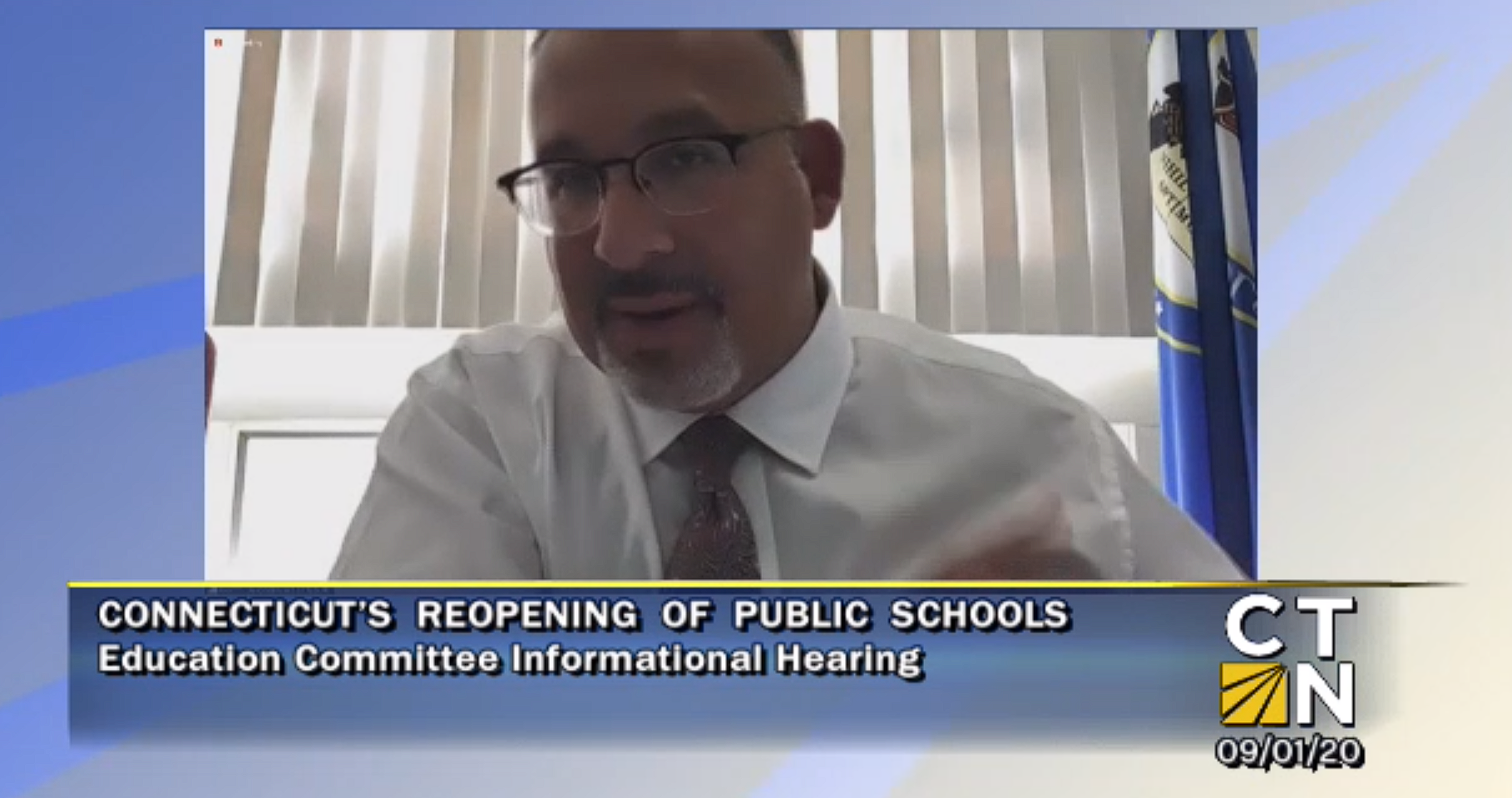“These are hard, difficult times we’re in,” State Rep. Robert Sanchez told his colleagues on the legislature’s Education Committee. “I hope we see all children going back to school in the next couple of weeks and there are no spikes, but we’ll see what happens.”
Sanchez’s remarks came during an informational hearing on school reopening that the Education Committee, which he co-chairs with Senator Doug McCrory, held with State Department of Education (SDE) officials this week. The legislators had numerous questions for SDE staff that covered everything from funding for school reopening to coronavirus testing to teachers seeking accommodations due to medical conditions.
State funding
Some superintendents have questioned the amount of additional funding they’re receiving from the state, which represents only a fraction of what they requested, and legislators had questions about how the per district funding amounts had been derived.
Education Commissioner Miguel Cardona said that over the summer the SDE asked districts how much they would need for the 2020-21 school year in additional funds in four categories: academic supports, student supports, cleaning/PPE/health/safety, and transportation.
“The state has provided 100 percent of the funding districts requested for cleaning supplies and PPE,” Cardona said. He added that funding requests for academic and student supports were prorated based on the number of students in a district and the need level of a district, but that full funding was provided for cleaning supplies and PPE for all districts.
In response to a question from Senator Mary Abrams about districts that might want to challenge the amount of funding they are receiving from the state, Cardona said, “If a district is struggling to open because it doesn’t have the money, then we need to hear about that.”
Governor Lamont and legislators have discussed the possibility of holding a special session of the legislature later this month, and CEA will continue advocating for the funding necessary to keep students and teachers safe.
Teachers as essential workers
Rep. Jillian Gilchrest asked about a recent declaration from the Trump White House labeling teachers as essential workers. Guidance from the Department of Homeland Security states that teachers showing no symptoms who have been exposed to the coronavirus can keep teaching and do not need to quarantine for 14 days.
Cardona said that there are no plans in Connecticut to follow that guidance. Per addendums five and nine to Connecticut’s back to school plan, “If you’ve been in contact with someone who has COVID within six feet for 15 minutes or more, you should quarantine. We don’t plan on changing that.”
Teachers seeking accommodations
Rep. Noreen Kokoruda asked how districts are handling teachers who are at a high risk for complications if they contract COVID.
“There are federal protections that teachers have and that should be adhered to,” Cardona said.
SDE Legal Director Jessa Mirtle said that she has heard from different districts who are taking different approaches and that the SDE has been working with the Department of Labor on the matter.
“We anticipate providing additional guidance to districts that is suitable for employees and supports the needs of districts,” she said.
Coronavirus testing
Senator Abrams said that many colleges and universities in the state are requiring students and faculty to be tested before they return in order to prevent an outbreak. “I know that there are private schools doing that. I’m wondering why that is not a requirement throughout the state to have all staff and students tested before returning to public schools?”
Cardona replied that testing was not one of the strategies recommended to his department to contain and reduce the spread of COVID, “though that’s not to say there’s no benefit.”
CEA’s Safe Learning Plan has called for testing all students and staff taking part in in-person learning as soon as practicable.
“I have not been in favor of reopening schools,” Abrams said. “I feel we’re falling short as far as CDC guidelines, and in other areas as well.”
District plans
At the end of July and beginning of August, the SDE collected data from districts as to which learning model—in-person, hybrid, or remote—they were planning to use when students returned; however, districts’ plans have been changing on a daily basis.
SDE Chief Performance Officer Ajit Gopalakrishnan said that the department plans to ask districts to report, on a weekly basis, what the learning model is that they are using that week in each school. The SDE will then share that data publicly via a map or spreadsheet on its website.
Remote learning guidance
Rep. Brian Farnen said that he recognized remote learning in the spring was an emergency measure implemented with no notice, but asked why the SDE is not requiring significant synchronous live instruction for districts or families choosing remote learning this fall.
Chief Academic Officer Irene Parisi said the SDE has been taking into account the lessons learned in the spring and will be providing a model school day and guidance for what remote schooling should look like in terms or synchronous learning and flex time. She said the department hopes to release that guidance this week.
If you see something, say something
“We know this is an unprecedented and likely unpredictable school year,” says CEA President Jeff Leake. “Together we will continue to ensure safe working conditions for teachers and safe learning conditions for students. We know there will be issues as we move forward and we are adapting a see something, say something campaign.”
Leake adds, “If something is not right or safety protocols are not being followed we will address the issues in the district and with the state to ensure that everyone is safe.”
Visit cea.org and CEA’s Coronavirus Information Center for the latest information on school reopenings.







